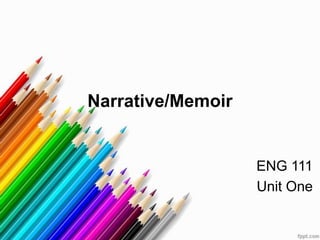
Narrative and memoir information
- 1. Narrative/Memoir ENG 111 Unit One
- 2. Narratives • Narratives are stories that are told for different purposes. • In college, students will be asked to relate their experiences dealing with different matters. There is also the narrative required on the college application.
- 3. Memoirs • Memoirs focus on events, people, and places that are important. • One usually writes a memoir to capture the important moment and to tell how it is important to him/her.
- 4. Key Features • A well-told story: Like most stories, those about literacy often set up some sort of situation that needs to be resolved or a question to be answered. • Vivid detail: Vivid details are what bring a story to life and help create the mental images of sights, sounds, smells, tastes, and textures of the world in which the story takes place.
- 5. Key Features Continued • Indication of narratives significance: A literacy narrative tells something about how the person learned to read or write. The writer must also make it clear why the event is important. A sort of moral of the story, if you will. – A memoir tells about the significance of the memory, while explaining what it means to the writer.
- 6. Choosing a Topic • Focus on the simple events during a brief period: – Any earlier memory about reading or writing – Someone who taught you to read or write – A book that is significant to you – An event at school that was interesting, humorous, or embarrassing, etc. – A memory you will never forget • Make a possible list of topics and choose one that you feel is interesting.
- 7. Considering the Rhetorical Situation • Purpose: Why do you want to tell the story? Think about the reasons and how they will shape what you write. • Audience: Who are your readers? Understanding your audience lets you know what you need to explain, if there would be similar experiences, and if they share your attitude.
- 8. Rhetorical Situation Cont. • Stance: What attitude do you want to project? The attitude will determine the tone you use when writing. • Media/Design: How will be the narrative be presented? There is print, oral, and web., and then there are photos, charts, or other illustrations that may be needed.
- 9. Generating Ideas and Text • Remember that the goal is to tell a story that is vivid and compelling for the reader. – Describe the setting: Where does it take place? What do you see? What do you hear? What do you smell? How and what do you feel? What do you taste? – Think of key people: People’s actions play an important part in the story. Describe each person in a paragraph or so. Recall (or imagine) some characteristic dialogue.
- 10. Generating Ideas and Text Cont. • Write about ―what happened‖: A good story dramatizes the action. Try to summarize what happened with active and specific verbs to describe as vividly as possible. Answer what, where, and who. • Consider the significance of the narrative: Be clear about why the event is important. How did it change or affect you?
- 11. Ways to Organize • Start by Outlining the main events. Then think about how you want to organize it. – Chronologically: from beginning to end – Beginning in the middle: start with the middle, fill in details, tell how situation was resolved, and why it was important. – Beginning at the end: tell how the story ends and then go back to the beginning to tell how it happened.
- 12. Writing Out a Draft • Once all the information is collected, it is time to begin writing. – Draft a beginning: jump right in with the main action; describe the context by giving background information; describe the setting—especially if it is important to the narrative.
- 13. Writing Out a Draft Cont. – Draft an ending: what do you want to leave the readers with. • End where your story ends • Say something about the significance of your narrative • Refer back to the beginning • End on a surprising note – Come up with a title. • A good title indicates something about subject and makes the audience want to read the narrative.
- 14. Considering Matters of Design Narratives are usually written in paragraph form. – What typeface? Essays are usually Times New Roman, Arial, or Calibri. – Any headings? Essays have a header with your name, teacher’s name, class, and date. – Any visuals? Short essays usually do not included visuals.
- 15. Getting Response and Revising • Getting responses from others is really important. – Does the title and beginning make the reader want to read more? – Are transitions used correctly to take the reader through the story? – Is anything confusing? – Are the details added and are the interesting? Does the reader know the setting? Is there dialogue?
- 16. Getting Response and Revising Cont. – Has the situation been made meaningful? – Are actions described vividly and clearly as to engage the reader? – Is the significance clear? – Is the ending satisfying and what does it leave the reader thinking? Once you have all the answers, it is time to revise.
- 17. Editing and Proofreading • Make sure events are narrated in clear order with proper transitions. • Make sure to have verb tense consistency. • Make sure verb tenses indicate when an action took place. • Punctuate dialogue correctly. • Proofread for other grammatical and usage issues.
- 18. Taking Stock in Your Work • How well did you tell the story? • What did you do well? • What could you improve? • How did you come up with ideas and generating texts? • How did you go about drafting the narrative? • How did others’ responses influence you?